When first venturing out into the world of guitar playing you may feel a little overwhelmed at all the new and unfamiliar aspects of becoming a guitarist.
One important decision that is often a point of confusion for a new guitar player is choosing the right guitar, so we have included this "Guitar Buyers Guide" to assist you.
The first decision regarding the purchase of a guitar is what "style" of guitar to go with. If you are unfamiliar with the various styles of guitars please refer to our tutorial on "Types of Guitars".
You mainly will choose from three different styles of guitar. Acoustic, Electric or Classical.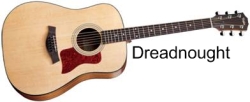
Acoustic Guitars
If you have decided to go with an acoustic guitar there are some considerations you should take into account.
Firstly, guitar necks are typically constructed with a "truss rod", which is an implanted metal shaft that that allows the neck to be adjusted periodically. This is necessary because the wood on the neck has a tendency to move and shift slightly in responses to changes in climate. Some very inexpensive guitars are made without a truss rod to save on manufacturing costs. These guitars should be avoided.
Secondly, you will want to make the investment in an acoustic guitar with a "solid top" as opposed to a laminate. A solid top will produce a better tone and will hold up better in the long run. You can purchase a nice solid top guitar without breaking the bank and it is well worth a few extra dollars.
You will also need to consider whether you want to go with a standard dreadnought size, a standard size with a "cutaway",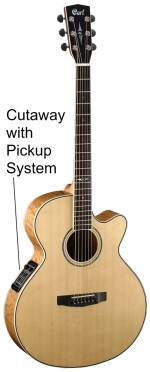 a jumbo or parlor size guitar or an acoustic with electronic pickups.
a jumbo or parlor size guitar or an acoustic with electronic pickups.
A standard dreadnought will be the choice for many, especially if you are shooting for playing guitar for enjoyment at home or with friends.
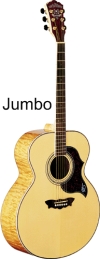 If you are looking toward playing a lot of "lead" guitar down the road, a guitar with a "cutaway" may make more sense for you. The cutaway design allows room for you hand to reach into the upper parts of the neck without the obstruction of a normal dreadnought.
If you are looking toward playing a lot of "lead" guitar down the road, a guitar with a "cutaway" may make more sense for you. The cutaway design allows room for you hand to reach into the upper parts of the neck without the obstruction of a normal dreadnought.
When choosing a "cutaway" style acoustic you may also want to consider getting one with an electronic "pickup" system already installed. This will enable you to plug the guitar into some form of amplification if you get into a band situation, or, into a recording device if you are concentrating on songwriting.
After-market pickups can be installed in an acoustic after you have purchased one, but it is usually less expensive to buy the guitar with the pickup system already installed.
A jumbo acoustic guitar has a larger body so you should "try one on for size" before going that route. Conversely, a parlor size acoustic has a small body and does not produce as much volume or tone as a standard body guitar. A parlor guitar has its uses but would not be a recommendation for your first guitar unless the small body size is a better fit for you.
Electric Guitars
Although electric guitars come in many shapes and sizes there are two models that are probably more recognized than any others. They are the 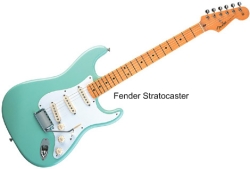 Fender Stratocaster and the Gibson LesPaul. Purchasing a new American made version of either of these would be a costly investment for the beginning guitar player but there are countless Strat and LesPaul clones on the market that are very nice guitars.
Fender Stratocaster and the Gibson LesPaul. Purchasing a new American made version of either of these would be a costly investment for the beginning guitar player but there are countless Strat and LesPaul clones on the market that are very nice guitars.
Like their acoustic counterparts, electric guitars are made of many various woods and the better the wood, the higher the cost. One consideration is the type of fretboard on the neck. Typically you will find either "rosewood" or "maple", and guitarists prefer one over the other for different reasons.
A rosewood neck produces a fatter tone with more "meat" to it, making it the preference for many. You can always tell a rosewood neck because it is a dark color wood.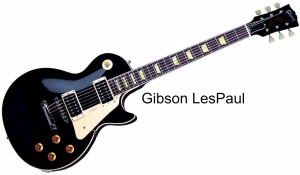
A maple neck produces a "brighter", cleaner tone and is popular with many country and blues players. You can recognize a maple neck because it is a light color wood.
Electric guitars also have a variety of different pickup combinations to consider. Usually you can break them down into two categories. "Single Coil" pickups and, "Humbucker" pickups.
Single coil pickups are usually associated with a "Stratocaster" sound which is a cleaner, brighter sound.
Humbucker pickups are basically two single coil pickups put together. They are called "humbucker" because they resist the tendency to "hum" that many single coil pickups do when in proximity to certain electrical conditions such as neon lights in a nightclub. Humbucker pickups are known for producing a thicker, "chunkier" tone closely associated with rock and metal.
There are many fine guitar companies that make very affordable electric guitars and you are in no way limited to the "Strat" or "LesPaul" type models out there. Those are just two of the most common body shapes.
It would pay to shop around a bit and do some research prior to a purchase. You will also want to keep in mind that with an electric guitar you will need to purchase an amplifier to hear yourself. In the beginning a small practice amp will do the trick until you decide if you want to start playing with a band down the road.
Classical Guitars
Classical guitars tend to have a smaller body than a dreadnought acoustic, but are larger than a "parlor" size guitar. The neck on a classical guitar is 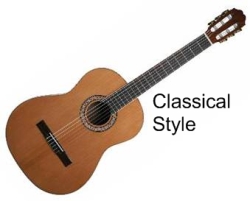 also wider than a standard acoustic, making fingering a little more difficult. They also use "nylon" strings which produce a softer tone and the strings are attached on a "slotted headstock". These guitars are designed for finger style playing and are not conducive to strumming with a pick.
also wider than a standard acoustic, making fingering a little more difficult. They also use "nylon" strings which produce a softer tone and the strings are attached on a "slotted headstock". These guitars are designed for finger style playing and are not conducive to strumming with a pick.
If you are definitely going in the direction of playing classical or flamenco music then a classical guitar is your choice. If, however, you are interested in playing country, rock, blues or folk music then one of the previously mentioned choices would be a better pick.
Another consideration is the "action" of the guitar. The action is described as the height of the strings off the plane of the neck. The lower the action, the easier the guitar is to play. The action can be adjusted by tweaking the truss rod and bridge of the guitar, but a guitar with a real high action to begin with, may be a sign of poor construction. This will make playing much more difficult and should be avoided.
There is no substitute for actually putting your hands on a guitar prior to purchase so it is always preferable to go to your local music store and try a few on for a good fit. If you are inclined to purchase a guitar online make sure the company has a strong return policy because you may have  to try a few guitars out before finding the right one.
to try a few guitars out before finding the right one.
Many guitars in the "under $100" category found in the "big box" retailers can be of inferior construction and may actually discourage you from playing. You can usually find a nice starter guitar in the $150 to $350 range that will last you a good long time. As with anything, "you get what you pay for" and opting for the cheapest guitar can actually cost you more in the long run if you have to upgrade in the first few months of playing, or, if you give up playing altogether out of frustration fighting a poorly constructed instrument.
Good luck shopping and please do not hesitate to contact us with any questions!
If you have not yet purchased a guitar or have already done so but are not be sure if you have made the right choice, this guide should help.
Guitars come in all shapes and sizes and are produced by many different manufacturers so choosing one can seem a little intimidating at first. The wealth of choices and price ranges alone can make it a daunting task. Let’s first simplify things by breaking it down to the general categories of guitars. As an overall rule there are three basic styles of guitars. Acoustic, electric and classical.
Acoustic Guitars are also known as box, folk or hollow body guitars. They are constructed of wood and normally have a sound hole cut into the top. An acoustic guitar produces sound naturally and does not require the use of amplification to be heard (unless played in a band setting). They typically use “bronze wound” guitar strings and can be strummed with a pick or played finger style. These are by far the most common guitars played by beginning students due to the availability of lesser expensive models and ease of use and transportation.
top. An acoustic guitar produces sound naturally and does not require the use of amplification to be heard (unless played in a band setting). They typically use “bronze wound” guitar strings and can be strummed with a pick or played finger style. These are by far the most common guitars played by beginning students due to the availability of lesser expensive models and ease of use and transportation.
Electric Guitars are, for the most part, solid body instruments and are wired with “pickups” that magnetically reproduce the sound. As a result, an 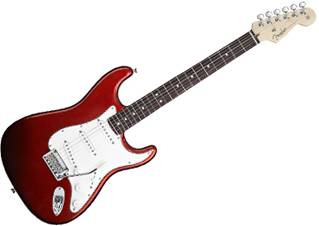 electric guitar typically requires the use of an amplifier to be heard. An electric guitar normally uses “nickel wound” strings that are usually lighter in gauge than acoustic guitar strings thereby making the electric guitar easier to play. There are good models available at an affordable price but one must also purchase an amplifier to go along with it. Electric guitars are often preferred by players interested in playing rock, blues, metal and lead country styles.
electric guitar typically requires the use of an amplifier to be heard. An electric guitar normally uses “nickel wound” strings that are usually lighter in gauge than acoustic guitar strings thereby making the electric guitar easier to play. There are good models available at an affordable price but one must also purchase an amplifier to go along with it. Electric guitars are often preferred by players interested in playing rock, blues, metal and lead country styles.
Classical Guitars are similar to acoustic guitars in that they are of a hollow body design and, as a result, do not require the use of an amplifier. They typically use nylon strings which produce a more mellow tone than an acoustic guitar, and tend to have a wider neck, which make them more conducive to a finger style type of playing. They can be easily identified by the “slotted” headstock and slightly smaller body. Classical Guitars are favored by guitarists pursuing classical and flamenco music and are the common choice for students in college guitar programs. We would not recommend this guitar to students interested in playing rock, blues or country music that requires strumming or the use of a pick.
programs. We would not recommend this guitar to students interested in playing rock, blues or country music that requires strumming or the use of a pick.
Your choice of guitar is, of course, ultimately up to you and according to what your preferences are. Although the acoustic guitar is the choice of many just starting out, if you know for sure that your goal is to play lead guitar in a rock or blues band then the electric might be a better pick. The classical guitar may not be your final choice but if you have access to one in the early days you will find that the nylon strings are easier on the fingers until you develop your calluses.
At the end of the day the important thing is that you get a guitar that meets your musical goals, budget and that you are comfortable with. Many veteran guitarists have several guitars in their arsenal and I can personally attest to that. I have acoustics, electrics and classical guitars and I play them all according to what type of gig or venue I am playing. If you play guitar for any length of time you will probably accumulate several yourself.
It’s great to save some money in the beginning but try to find a happy medium between thrift and quality. I have seen students who buy a cheap guitar starting out and end up losing interest in playing because they purchased an inexpensive model. These can often be poorly constructed and much more difficult to play. Many of the guitars that are sold at the “big box” discount stores fall into this category. Our recommendation would be to go to your local music store where you can actually “lay hands” on various models.
I know you can save a few dollars buying a guitar online but guitars, by nature, are fickle, and each one plays a little differently, each tends to have it’s own personality. As a result, there is no substitute for picking one out that you can touch and play at a music store with the help of a trained pro.




 a jumbo or parlor size guitar or an acoustic with electronic pickups.
a jumbo or parlor size guitar or an acoustic with electronic pickups.  If you are looking toward playing a lot of "lead" guitar down the road, a guitar with a "cutaway" may make more sense for you. The cutaway design allows room for you hand to reach into the upper parts of the neck without the obstruction of a normal dreadnought.
If you are looking toward playing a lot of "lead" guitar down the road, a guitar with a "cutaway" may make more sense for you. The cutaway design allows room for you hand to reach into the upper parts of the neck without the obstruction of a normal dreadnought.  Fender Stratocaster and the Gibson LesPaul. Purchasing a new American made version of either of these would be a costly investment for the beginning guitar player but there are countless Strat and LesPaul clones on the market that are very nice guitars.
Fender Stratocaster and the Gibson LesPaul. Purchasing a new American made version of either of these would be a costly investment for the beginning guitar player but there are countless Strat and LesPaul clones on the market that are very nice guitars.
 also wider than a standard acoustic, making fingering a little more difficult. They also use "nylon" strings which produce a softer tone and the strings are attached on a "slotted headstock". These guitars are designed for finger style playing and are not conducive to strumming with a pick.
also wider than a standard acoustic, making fingering a little more difficult. They also use "nylon" strings which produce a softer tone and the strings are attached on a "slotted headstock". These guitars are designed for finger style playing and are not conducive to strumming with a pick. to try a few guitars out before finding the right one.
to try a few guitars out before finding the right one. top. An acoustic guitar produces sound naturally and does not require the use of amplification to be heard (unless played in a band setting). They typically use “bronze wound” guitar strings and can be strummed with a pick or played finger style. These are by far the most common guitars played by beginning students due to the availability of lesser expensive models and ease of use and transportation.
top. An acoustic guitar produces sound naturally and does not require the use of amplification to be heard (unless played in a band setting). They typically use “bronze wound” guitar strings and can be strummed with a pick or played finger style. These are by far the most common guitars played by beginning students due to the availability of lesser expensive models and ease of use and transportation. electric guitar typically requires the use of an amplifier to be heard. An electric guitar normally uses “nickel wound” strings that are usually lighter in gauge than acoustic guitar strings thereby making the electric guitar easier to play. There are good models available at an affordable price but one must also purchase an amplifier to go along with it. Electric guitars are often preferred by players interested in playing rock, blues, metal and lead country styles.
electric guitar typically requires the use of an amplifier to be heard. An electric guitar normally uses “nickel wound” strings that are usually lighter in gauge than acoustic guitar strings thereby making the electric guitar easier to play. There are good models available at an affordable price but one must also purchase an amplifier to go along with it. Electric guitars are often preferred by players interested in playing rock, blues, metal and lead country styles. programs. We would not recommend this guitar to students interested in playing rock, blues or country music that requires strumming or the use of a pick.
programs. We would not recommend this guitar to students interested in playing rock, blues or country music that requires strumming or the use of a pick.






